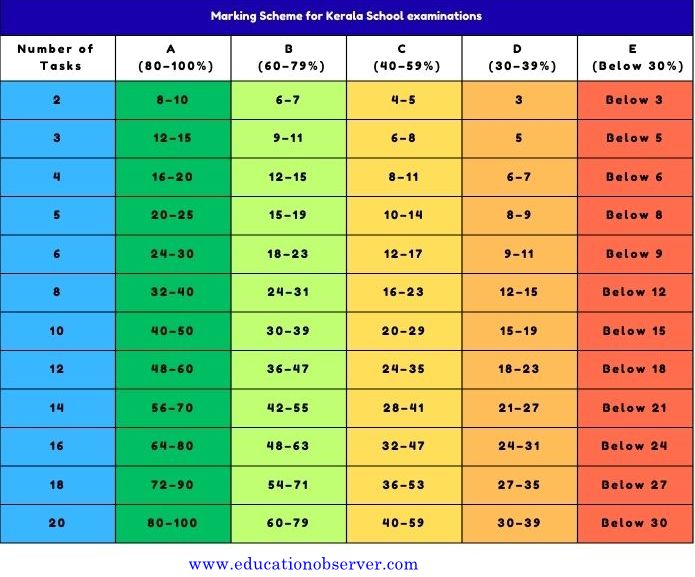Kerala education department has decided to revise the grading system and introduced a mandatory minimum 30% marks per subject requirement for students in Classes 5 through 9 in written year-end exams. This move is about bringing every student up to a desirable baseline set by the curriculum.
Implementation of the new system is aimed to
- Raise Academic Standards: The policy ensures students master core concepts before promotion—not just progress without adequate subject-wise competence.
- Early Detection of Learning Gaps: By ensuring subject-level competency through written exams, weaknesses are identified early, enabling timely interventions.
- Structured Remediation: Additional study support and re-exams give students a fair second chance, rather than being penalized outright.
New Marking Scheme and Grading Scale
The minimum marks for getting each grade is as follows
| Number of Tasks | A (80–100%) | B (60–79%) | C (40–59%) | D (30–39%) | E (Below 30%) |
|---|---|---|---|---|---|
| 2 | 8–10 | 6–7 | 4–5 | 3 | Below 3 |
| 3 | 12–15 | 9–11 | 6–8 | 5 | Below 5 |
| 4 | 16–20 | 12–15 | 8–11 | 6–7 | Below 6 |
| 5 | 20–25 | 15–19 | 10–14 | 8–9 | Below 8 |
| 6 | 24–30 | 18–23 | 12–17 | 9–11 | Below 9 |
| 8 | 32–40 | 24–31 | 16–23 | 12–15 | Below 12 |
| 10 | 40–50 | 30–39 | 20–29 | 15–19 | Below 15 |
| 12 | 48–60 | 36–47 | 24–35 | 18–23 | Below 18 |
| 14 | 56–70 | 42–55 | 28–41 | 21–27 | Below 21 |
| 16 | 64–80 | 48–63 | 32–47 | 24–31 | Below 24 |
| 18 | 72–90 | 54–71 | 36–53 | 27–35 | Below 27 |
| 20 | 80–100 | 60–79 | 40–59 | 30–39 | Below 30 |

What do the grades mean ?
A Grade (80–100%) → Excellent performance
- B Grade (60–79%) → Very good performance
- C Grade (40–59%) → Satisfactory performance
- D Grade (30–39%) → Needs improvement
- E Grade (Below 30%) → Unsatisfactory
Activity-Based Grading and Examination Marks Conversion
Each activity carries a maximum of 5 marks. Instead of giving the raw marks directly, students are graded (A, B, C, D, E). Each grade corresponds to a fixed mark value, as shown below:
| Grade | Mark Value (per activity) |
| A | 5 marks |
| B | 4 marks |
| C | 3 marks |
| D | 2 marks |
| E | 1 mark |
This ensures uniformity in evaluation, where each grade has a numerical equivalent for calculating totals.
Total Marks Calculation
If a question paper has 5 activities, then:
- Maximum possible score = 5 activities × 5 marks each = 25 marks
- A student’s total score is the sum of the grade-based marks received in each activity.
Examination Grade Assignment
The total marks obtained from all activities are converted into an overall examination grade according to fixed cut-off ranges.
| Total Score (out of 25) | Examination Grade |
| 20 – 25 | A |
| 15 – 19 | B |
| 10 – 14 | C |
| 5 – 9 | D |
| Below 5 | E |
Example Calculation
Suppose a student attempts 5 activities and receives the following grades:
- Activity 1 → A (5 marks)
- Activity 2 → B (4 marks)
- Activity 3 → A (5 marks)
- Activity 4 → C (3 marks)
- Activity 5 → B (4 marks)
Total = 5 + 4 + 5 + 3 + 4 = 21 marks
Since the student scored 21/25, the overall examination grade = A.

